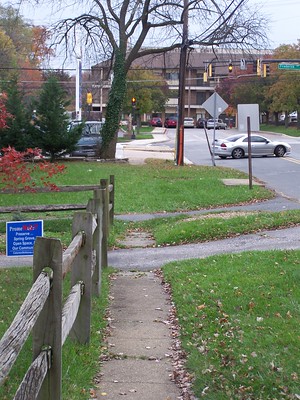Interesting idea from Professor Donald Shoup about how to improve house-fronting public spaces
UCLA planning professor Donald Shoup, best known to the more general but planning knowledgeable public for his book The High Cost for Free Parking and his consultation with many communities, starting in Pasadena, on parking, transportation, and commercial district revitalization, wrote this post below in a discussion on the pro-urb e-list. (Reprinted with permission.)
[Interestingly, here, I write that cities should take on the financial responsibility for sidewalks, "A walking (or sustainable mobility prioritized) city should take responsibility for constructing sidewalks, 2016." But this offers a different approach.]
From Professor Shoup:
Most cities need safer sidewalks and more street trees, but many cities can’t or don’t want to pay for them.
One way to solve the finance problem is to require property owners to repair any broken sidewalk or plant any missing street tree in front of their property before they sell the property. This pay-on-exit policy systematically improves all streetscapes in a surprisingly short time at no cost to taxpayers. Owners who sell their property and leave the neighborhood make all the public improvements.
-- "Op-Ed: A big step toward safer sidewalks," Los Angeles Times, 2014
-- "Let a Tree Grow in L.A.," Los Angeles Times, 1996
-- "Fixing Broken Sidwalks, Access Magazine, 2016
-- "Regulating Land Use at Sale: Public Improvement from Private Investment ," Journal of the American Planning Association, 1996
-- "Putting Cities Back On Their Feet," Journal of Urban Planning and Development, 2010

This sidewalk has a section made of rubber, to allow for tree root upthrust.
End of Donald Shoup post.
Conclusion. I wish that I had known about this concept--many of the articles are from the 1990s--when I was doing the Western Baltimore County Pedestrian and Bicycle Access Plan. I would have included this as a policy recommendation.
I know for sure it would have never made it out of the internally circulated draft, but it still would have pushed the discourse forward.
Note that this idea should should be extended to include putting in sidewalks where there is a gap in the network. Astute jurisdictions--this includes Baltimore County but not DC--add easements to lots when plans call for the construction of trails (and presumably sidewalks.


Catonsville, Baltimore County, Maryland.

Salt Lake City
That way when they properties get developed, the trail/sidewalk can be added when it's constructed. (Although typically they provide outs for the developer to avoid doing this.)
But usually this is for commercial properties and large tract new developments, not individual residential properties.
July 26th is the 30th Anniversary of the Americans for Disability Act
Note that this post is pretty timely because this week is the 30th anniversary of when the Americans for Disability Act went into effect. See "Building Accessibility Into America, Literally," New York Times.
Labels: "streets as places", bicycle and pedestrian planning, disability planning, integrated public realm framework, neighborhood planning, sidewalks, sustainable mobility platform, trees, urban design/placemaking




0 Comments:
Post a Comment
<< Home